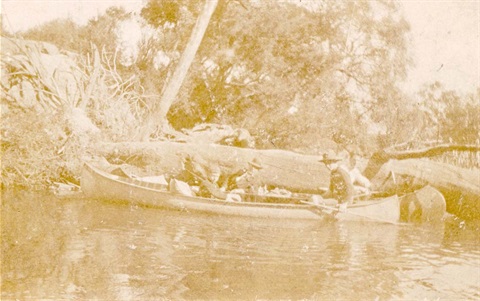Fairfield Canoe Club

The Fairfield Canoe Club was formed in 1919. Its first home was the Fairfield Boat Shed but friction with the owner soon had club members planning construction of the club’s own headquarters. One cause of friction was the lack of storage space inside the shed which meant that the Canoe Club’s boats had to be hung on trees outside in the elements. A piece of land was purchased on the Esplanade following which further funds were raised and construction of a club house commenced. This building was finished in 1926 and saw the beginning of a new era for the Fairfield Canoe Club.
Most of the racing was done in Canadian 18 foot canoes for singles and doubles and Canadian 26 foot canoes for 4 person events. These longer canoes were also sometimes used for two person events at championship events. Races were held over 440 yards for all classes, and there were also 7 and 10 mile events for singles and doubles. Some of the clubs which Fairfield competed against in those days were Essendon, Hawthorn Glen, Elwood (sea), Brighton (sea) and Burnley.
The Great Depression brought a period of financial hardship which nearly ended the life of the Fairfield Canoe Club. In fact, the Club was forced into bankruptcy and at its lowest ebb even considered a proposal to sell the club house so it could be converted into flats. In the end a more acceptable solution was to create the Heidelberg Rowing Club and shift the focus of the club from canoeing to rowing. A loan of £5,000 was obtained, with which the new club purchased boats and other equipment. However it was almost all for nothing after the 1934 floods. The club house was nearly washed away as the rooms became flooded with up to two feet of water in some places. Fortunately the building survived.
During the Second World War the club’s activity was all but suspended with most members enlisting. The only activity was Sunday morning rowing which was followed by some drinks amongst members which raised just enough money to keep the club going. Early in 1942 the winds of change began to blow at Heidelberg Rowing Club when a few new members, including Tom Ohman, started canoeing. As the war drew to a close and more members returned, it was canoeing that flourished while rowing was left by the wayside.
After ten years of paying interest only on the original £5,000 loan, the principal remained and the lender called in the loan. The Club decided to sell off all the rowing boats as canoeing had become the primary interest of the members. This helped the Club clear the loan once and for all. The Fairfield Canoe Club named returned and the VACA was reformed which led to a resumption of competitions. Fairfield became the outstanding club, winning many state titles over the next decade.
The 1950s saw a shift away from Canadian canoes to newer, faster Swedish canoes. The decade also saw the arrival of kayaks. In 1956 Club legend Tom Ohman was part of Australia’s Olympic team and placed a respectable 5th and 7th in his two events. Fairfield also provided Australian Olympians in the 1960 and 1964 Olympics. In the 1980s Fairfield Canoe Club was able to erect a new club house which had additional storage, change rooms and meeting facilities without losing direct access to the Yarra. The club is currently as strong as ever with a growing membership and solid reputation for being a fun and relaxed recreational club.
Ohman, Tom. “History of Fairfield Canoe Club: A brief history from 1919-1964” [Online]. Fairfield Canoe Club. WWW Resource, Accessed 6/9/2022, Available at: https://www.fairfieldcanoeclub.org.au/history
“Why is FCC such a great club?” [Online]. Fairfield Canoe Club. WWW Resource, Accessed 3/11/2006, Available at: http://www.fairfieldcanoeclub.org.au/welcome/why_fcc.htm
“Canoeing on/Swimming in the Yarra” [Online]. National Film and Sound Archive. WWW Resource, Accessed 3/11/2006, Available at: http://www.nfsa.afc.gov.au/Screensound/Screenso.nsf/AllDocs/5568605D33BB0ACDCA256DAB0024A49F?OpenDocument